This article needs additional citations for verification .(October 2023) |
F-type asteroids are a relatively uncommon type of carbonaceous asteroid, falling into the wider C-group. [1]
This article needs additional citations for verification .(October 2023) |
F-type asteroids are a relatively uncommon type of carbonaceous asteroid, falling into the wider C-group. [1]
F-type asteroids have spectra generally similar to those of the B-type asteroids, but lack the "water" absorption feature around 3 μm indicative of hydrated minerals, and differ in the low wavelength part of the ultraviolet spectrum below 0.4 μm.
The F-type and B-type asteroids are not distinguishable with the criteria used in the SMASS classification, so in that scheme are grouped together under the B-type.

Antlia is a constellation in the Southern Celestial Hemisphere. Its name means "pump" in Latin and Greek; it represents an air pump. Originally Antlia Pneumatica, the constellation was established by Nicolas-Louis de Lacaille in the 18th century. Its non-specific (single-word) name, already in limited use, was preferred by John Herschel then welcomed by the astronomic community which officially accepted this. North of stars forming some of the sails of the ship Argo Navis, Antlia is completely visible from latitudes south of 49 degrees north.

Apus is a small constellation in the southern sky. It represents a bird-of-paradise, and its name means "without feet" in Greek because the bird-of-paradise was once wrongly believed to lack feet. First depicted on a celestial globe by Petrus Plancius in 1598, it was charted on a star atlas by Johann Bayer in his 1603 Uranometria. The French explorer and astronomer Nicolas Louis de Lacaille charted and gave the brighter stars their Bayer designations in 1756.
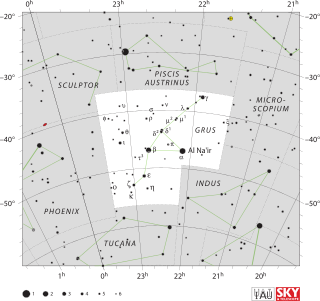
Grus is a constellation in the southern sky. Its name is Latin for the crane, a type of bird. It is one of twelve constellations conceived by Petrus Plancius from the observations of Pieter Dirkszoon Keyser and Frederick de Houtman. Grus first appeared on a 35-centimetre-diameter (14-inch) celestial globe published in 1598 in Amsterdam by Plancius and Jodocus Hondius and was depicted in Johann Bayer's star atlas Uranometria of 1603. French explorer and astronomer Nicolas-Louis de Lacaille gave Bayer designations to its stars in 1756, some of which had been previously considered part of the neighbouring constellation Piscis Austrinus. The constellations Grus, Pavo, Phoenix and Tucana are collectively known as the "Southern Birds".
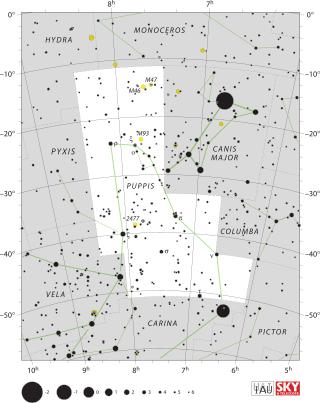
Puppis is a constellation in the southern sky. Puppis, the Latin translation of "poop deck", was originally part of an over-large constellation Argo Navis, which centuries after its initial description, was divided into three parts, the other two being Carina, and Vela. Puppis is the largest of the three constellations in square degrees. It is one of the 88 modern constellations recognized by the International Astronomical Union.

Telescopium is a minor constellation in the southern celestial hemisphere, one of twelve named in the 18th century by French astronomer Nicolas-Louis de Lacaille and one of several depicting scientific instruments. Its name is a Latinized form of the Greek word for telescope. Telescopium was later much reduced in size by Francis Baily and Benjamin Gould.
A V-type asteroid or Vestoid is an asteroid whose spectral type is that of 4 Vesta. Approximately 6% of main-belt asteroids are vestoids, with Vesta being by far the largest of them. They are relatively bright, and rather similar to the more common S-type asteroid, which are also made up of stony irons and ordinary chondrites, with V-types containing more pyroxene than S-types.

Sculptor is a faint constellation in the southern sky. It represents a sculptor. It was introduced by Nicolas Louis de Lacaille in the 18th century. He originally named it Apparatus Sculptoris, but the name was later shortened.
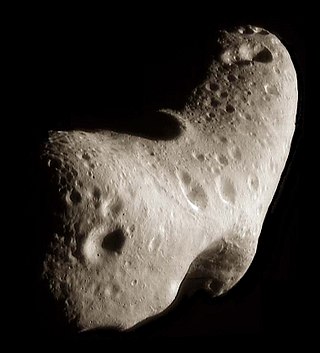
S-type asteroids are asteroids with a spectral type that is indicative of a siliceous mineralogical composition, hence the name. They have relatively high density. Approximately 17% of asteroids are of this type, making it the second-most common after the carbonaceous C-type.

C-typeasteroids are the most common variety, forming around 75% of known asteroids. They are volatile-rich and distinguished by a very low albedo because their composition includes a large amount of carbon, in addition to rocks and minerals. They have an average density of about 1.7 g/cm3.
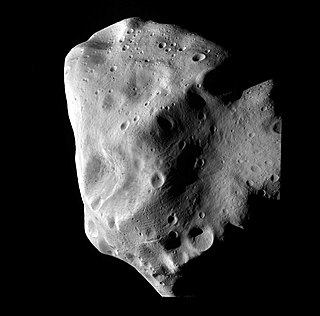
M-type asteroids are a spectral class of asteroids which appear to contain higher concentrations of metal phases than other asteroid classes, and are widely thought to be the source of iron meteorites.
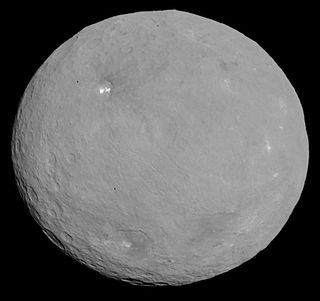
G-type asteroids are a relatively uncommon type of carbonaceous asteroid that makes up approximately 5% of asteroids. The most notable asteroid in this class is 1 Ceres.

B-type asteroids are a relatively uncommon type of carbonaceous asteroid, falling into the wider C-group; the 'B' indicates these objects are spectrally blue. In the asteroid population, B-class objects can be found in the outer asteroid belt, and also dominate the high-inclination Pallas family which includes the third-largest asteroid 2 Pallas. They are thought to be primitive, volatile-rich remnants from the early Solar System. There are 65 known B-type asteroids in the SMASS classification, and 9 in the Tholen classification as of March 2015.

Lutetia is a large M-type asteroid in the main asteroid belt. It measures about 100 kilometers in diameter. It was discovered in 1852 by Hermann Goldschmidt, and is named after Lutetia, the Latin name of Paris.

Hertha is an asteroid from the inner region of the asteroid belt, approximately 77 kilometers in diameter. Discovered on 18 February 1874 by German–American astronomer Christian Peters at the Litchfield Observatory near Clinton, New York, it was named after the Teutonic and Scandinavian goddess of fertility, Hertha, also known as Nerthus. It orbits among the Nysa asteroid family, but its classification as a metallic M-type asteroid does not match the more common F-type asteroid for this family, suggesting that it may be an interloper. Spectroscopic analysis indicates the possible presence of hydrated silicates indicating that Hertha should possibly be reclassified from its present M-type to the proposed W-type.
K-type asteroids are relatively uncommon asteroids with a moderately reddish spectrum shortwards of 0.75 μm, and a slight bluish trend longwards of this. They have a low albedo. Their spectrum resembles that of CV and CO meteorites. A larger K type is 9 Metis.
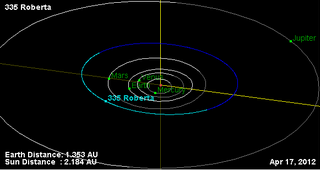
Roberta is a large main belt asteroid. It was discovered on 1 September 1892, by German astronomer Anton Staus at Heidelberg Observatory. Roberta was the 12th asteroid that was discovered using photography, and the only asteroid discovery made by Staus.

Alpha Telescopii, Latinized from α Telescopii, is the brightest star in the southern constellation of Telescopium, with an apparent visual magnitude of 3.5. The ancient Roman astronomer Ptolemy included it in the constellation Corona Australis, but it was moved to Telescopium when that constellation was created by French astronomer Nicolas Louis de Lacaille in the 18th century. Parallax measurements put it at a distance of 278 light-years from Earth. At that range, the visual magnitude of the star is diminished by an extinction of 0.22 due to interstellar dust.

An asteroid spectral type is assigned to asteroids based on their reflectance spectrum, color, and sometimes albedo. These types are thought to correspond to an asteroid's surface composition. For small bodies that are not internally differentiated, the surface and internal compositions are presumably similar, while large bodies such as Ceres and Vesta are known to have internal structure. Over the years, there has been a number of surveys that resulted in a set of different taxonomic systems such as the Tholen, SMASS and Bus–DeMeo classifications.
The X-group of asteroids collects together several types with similar spectra, but probably quite different compositions.
The Padua family, also known as the Lydia family, is a mid-sized family of asteroids of more than a thousand members.